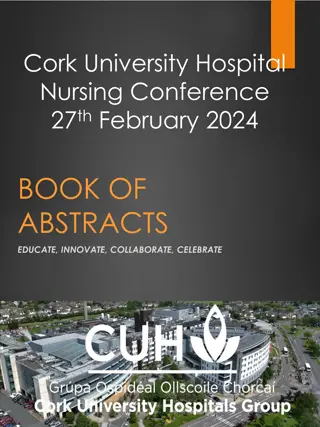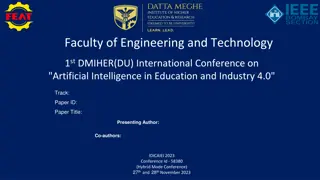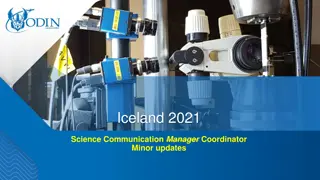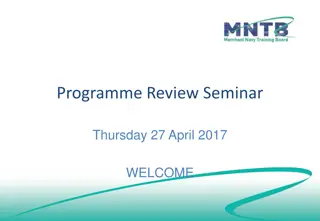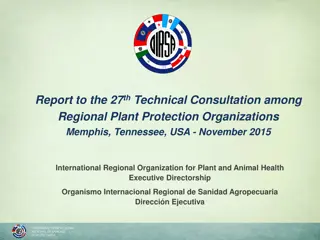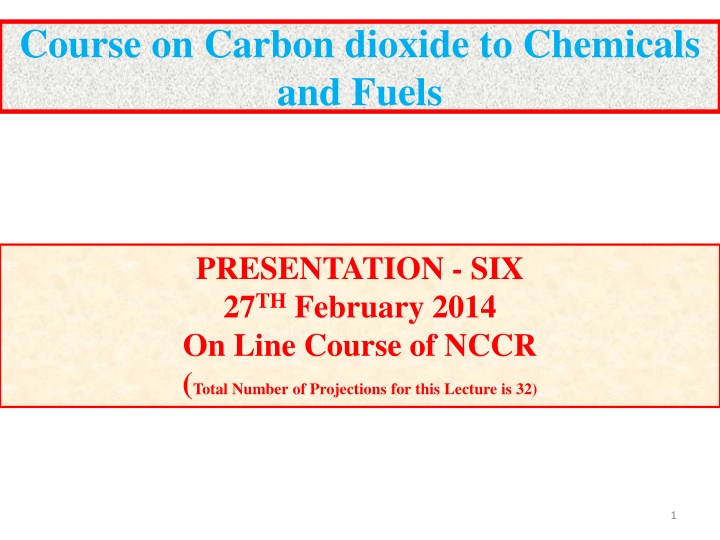
Transforming Carbon Dioxide to Fuels: Innovative Catalyst Technology
Explore the process of dry reforming of carbon dioxide with methane to produce synthesis gas, essential for combating greenhouse gas emissions. Delve into catalyst systems, relevant reactions, and the role of components, shedding light on a sustainable energy future. Discover the catalyst technology for this transformation and its potential impact on the automotive and aviation industries.
Download Presentation

Please find below an Image/Link to download the presentation.
The content on the website is provided AS IS for your information and personal use only. It may not be sold, licensed, or shared on other websites without obtaining consent from the author. If you encounter any issues during the download, it is possible that the publisher has removed the file from their server.
You are allowed to download the files provided on this website for personal or commercial use, subject to the condition that they are used lawfully. All files are the property of their respective owners.
The content on the website is provided AS IS for your information and personal use only. It may not be sold, licensed, or shared on other websites without obtaining consent from the author.
E N D
Presentation Transcript
Course on Carbon dioxide to Chemicals and Fuels PRESENTATION - SIX 27TH February 2014 On Line Course of NCCR (Total Number of Projections for this Lecture is 32) 1
FOCUS This Lecture mainly deals with reforming of carbon dioxide with methane for synthesis gas
COVERAGE THERMODYNAMICS TEMPERATURE RANGE CATALYST SYSTEMS ROLE OF THE COMPONENTS OTHER RELEVANT REACTIONS REACTORS
DRY REFORMING OF CARBON DIOXIDE Carbon dioxide reforming (dry reforming) is for producing synthesis gas by the reaction of CO2 with hydrocarbons especially methane. Synthesis gas is conventionally produced via the steam reforming of naphtha. This has relevance to the concern on the greenhouse gases to global warming. It is a method of replacing steam as reactant with carbon dioxide. The methane carbon dioxide reforming reaction is: CO2 + CH4 2H2 + 2CO Halmann, Martin M. (1993). Carbon di oxide reforming. Chemical fixation of carbon dioxide: methods for recycling CO2 into useful products. CRC Press. ISBN 978-0-8493-4428-2 Halmann, Martin M. (1993). "Carbon Dioxide Reforming". Chemical fixation of carbon dioxide: methods for recycling CO2 into useful products. CRC Press. ISBN 978-0-8493-4428-2
Catalyst Technology for carbon dioxide reforming with methane to synthesis gas Mun-Sing Fan et al., ChemCatChem, 1,192 (2009)
Carbon dioxide Reforming Scheme O=C=O Methane Catalyst(?) Storage in gas Pressure vessels STORAGE Gas stations SYN GAS (CO /H2) TRANSPORT SECTOR AUTOMOBILES, DIESEL ENGINES AEROPLANES
RELEVANT REACTIONS (1)CH4+ CO2 2CO + 2H2 H0298=247 G0=61770-67.3T (2)CH4+H2O (3)CH4 C + 2H2 75; 2190-26.5T (4)2CO CO2+ C -171; 39810+40.9T (5)CO2+ H2 CPO + H2O 41; -8545+7.84T (6)CO + H2 C + H2O -131 The first figure refer to the H0298 in kJ/mol The second figure refer to G0 CO + 3H2 =206; Reaction T (K) DRM 913 Methane cracking (3) 830 Boudouard Reaction (4) 973 RWGS (5) 1093 Limiting temperatures for different reactions DRM
Catalyst component and corresponding proposed mechanism Catalyst component Proposed mechanism Metal active site (M(as)) CH4 + 2M(as) CH3-M(as)+ H-M(as) CH3-M(as)+ M(as) CH2-M(as) + H-M(as) CH2-M(as) + M(as) CH-M(as)+H-M(as) CH-M(as) + M(as) C-M(as) + H-M(as) 2h-M(as) H2(g) +2M+(as) Mun-Sing Fan et al., ChemCatChem, 1,192 (2009)
Catalyst component Proposed Mechanism Support ( Acidic support) CO(g) CO2(metal) CO2(metal) CO(metal) + O(metals) CO(metal) CO(g) CO2(g) CO2(support) Support ( BASIC SUPPORT) CO2(support) + O2-(support) CO3(support)2- 2H(metal) 2H(support) CO3(support)2- +2H(support) HCO3-(s) + OH- (s) CO(support) CO(g) Mun-Sing Fan et al., ChemCatChem, 1,192 (2009)
Catalyst component Proposed Mechanism Promoter CO(g) CO(support)+ O(promoter) O(promoter) + C(metal) CO(g) Mun-Sing Fan et al., ChemCatChem, 1,192 (2009
Different types of catalysts used for the DRM reaction Catalyst Temp. (K) 873-1123 973-1073 873 873 Conversion % Remarks 80-100(CH4) 28-35 41-46(CH4) 18-50 High selectivity deactivation Better than Ni preparation NiO/CaO/CoO-MgO/MgO Ru/SiO2/MgO/TiO2 Co/SiO2/MgO-SiO2 Ir/Al2O3 Mun-Sing Fan et al., ChemCatChem, 1,192 (2009
Characterization of DRM reaction catalysts Catalyst type Monometallic supported catalysts Ni/CeO2,Pt/Al2O3,Ni/SiO2,Ru/SiO2,Ir/Al2O3 Bimetallic supported catalysts Ni-Co, Ni- Rh Techniques XRD,TPR,XPS,EPR,TPO,TPH Aspects Metal dispersion, reducibility, coke Composition, phase, coke, metal dispersion Resistance to C, phases Carbon, active sites, reduction behaviour Calcination temp, structure, phases, reversibility, sintering XRD,XRF,XPS,TG,DTA, chemisorption Metal oxide supported catalysts CoO- MgO/CeO2 Promoted supported catalysts on alumina Ni-K,Ni-Sn,Ni-Ca,Ni-Mn Perovskite catalysts, LaNiOx, LaNiMgOx, LaNiCoOx, LaSrNiOx,LaCeNiOx TPO, XRD,XPS TG,TPH,TPR,XRD,TEM,TPO XRD,TPR,TPO,TEM,SEM Mun-Sing Fan et al., ChemCatChem, 1,192 (2009
Catalyst Technology for carbon dioxide reforming with methane to synthesis gas Mun-Sing Fan et al., ChemCatChem, 1,192 (2009)
Catalyst Technology for carbon dioxide reforming with methane to synthesis gas Mun-Sing Fan et al., ChemCatChem, 1,192 (2009)
Catalyst Technology for carbon dioxide reforming with methane to synthesis gas Mun-Sing Fan et al., ChemCatChem, 1,192 (2009)
Catalyst Technology for carbon dioxide reforming with methane to synthesis gas Mun-Sing Fan et al., ChemCatChem, 1,192 (2009)
CO2 reforming on Ni/Cu catalyst Factors like addition of copper to supported Ni system surface geometry, electronic structure, the extent of CH2 species, and hydrogen spill over contribute to Ni- Cu/support catalyst in CO2 reforming. 1. 1 wt% Cu8 wt% Ni/siO2 stability >7600C 2. active site is stabilized by Cu 3. Carbon formation same as Ni and Ni/Cu 4. Cu-Ni species inhibit the C formation 5. Cu addition promotes CH4 cracking and inactive Coke does not accumulate on Cu/Ni catalyst H-W Chen et al., Catalysis Today 97,173 (2004)
TD favours carbon formation Noble metals and Ni alleviate this problem
Summary of Catalytic Reforming of CO2/CH4 conversion ( %) CO2/C H4 Temp (K) Catalyst Ni/NaY 1:1 84.0 873 Ni/Al2O3 1:1 36.3 873 Ni/SiO2 1:1 14.9 873 Pd/NaY 1:1 29.2 873 Pt/NaY 1:1 156.3 873 KNiCa/Al2O3 1:1 17 923 KNiCa/SiO2 1:1 21 923 KNiCa/ZSI 1:1 78 923 Rh/TiO2 1:1 88.2 893 Rh/SiO2 1:1 5.1 893 Rh/Al2O3 1:1 85.1 893 Ni/Al2O3 1:1 80 90 1050 Pd/Al2O3 1:1 70 75 1050 Ru/Al2O3 1:1 60 70 1050 Rh/Al2O3 1:1 85 90 1050 Ir/Al2O3 1:1 85 90 1050 Wang et al, Energy & Fuels, 10,896 (1996)
Table Catalytic reforming of CO2/CH4 with 1:1 mixture on various catalysts collected from literature Catalyst Conversion % 15-85 29, 70-75,84 156,85 88,5,85 75,,100,86,88,100 1050,1213 60,75,90, 88,85 Temperature, K 873 873,1050,963 873,963 893 Ni/NaY/Al2O3/SiO2/ Pd/NaY/Al2O3/MgO Pt/NaY/MgO Rh/TiO2/SiO2/Al2O3 Ni/Al2O3/MgO-Al2O3/CaO-Al2O3/CaO-TiO2Al2O3 Ru/Al2O3/Eu2O3/MgO Ir/Eu2O3/Al2O3/ 1050,923,963 1000,1050
Summary of Catalytic Reforming of CO2/CH4 Co,MgO/C 1:1 65 75 923 Ni/CaO-MgO 1:1 80 1123 Rh/Al2O3 1:1 85 1073 Ru/Al2O3 1:1 83 1073 Ru/Eu2O3 1:1 75 923 Ir/Eu2O3 1:1 88 1000 Ru/MgO 1:1 90 963 Rh/MgO 1:1 88 963 Pt/MgO 1:1 85 963 Pd/MgO 1:1 84 963 Ni/Al2O3 2.38:1 100 1213 Ni/MgO Al2O3 2.38:1 86 1211 Ni/CaO Al2O3 2.01:1 88 1211 Ni/CaO TiO2 Al2O3 2.01:1 100 1223 Wang et al, Energy & Fuels, 10,896 (1996)
Catalytic Activities of Metals on Various Supports metal activity metal loading (wt %) temp (K) 1. Al2O3 Rh > Pd > Ru > Pt > Ir 1 823 Rh>Pd>Pt>Ru 0.5 1 823 973 Ir > Rh > Pd > Ru 1 1050 Ni>Co >>Fe 9 773 973 Ni>Co>> Fe 10 1023 Ru > Rh 0.5 873 Ru > Ru 0.5 923 1073 2. SiO2 Ru > Rh > Ni > Pt > Pd 1 973 Ni > Ru > Rh >Pt > Pd >> Co 0.5 893 3. MgO Rh > Ru > Ir > Pt > Pd 0.5 1073 Ru > Rh > Ni > Pd > Pt 1 973 Ru> Rh ~Ni > Ir > Pt > Pd 1 823 Ru > Rh > Pt > Pd 1 913 4. Eu2O3 Ru > Ir 1 5 873 973 5. NaY Ni > Pd > Pt 2 873 Wang et al, Energy & Fuels, 10,896 (1996)
Effect of Support on Catalyst Activity metal loading (wt %) temp (K) activity order Ru Al2O3> TiO2 > SiO2 893 0.5 TiO2> Al2O3 > SiO2 893 0.5 Pd TiO2> Al2O3 > NaY > SiO2 > MgO > Na-ZSM-5 773 5 TiO2> Al2O3 > SiO2 > MgO 773 1 Rh YSZ > Al2O3 >TiO2 >SiO2>> MgO Al2O3> SiO2 > TiO2 > MgO 923 0.5 773 1 Ni Al2O3> SiO2 800 1000 40 Al2O3> SiO2 873 10 NaY > Al2O3 > SiO2 873 2 SiO2> ZrO2 > La2O3 > MgO > TiO2 823 4 Wang et al, Energy & Fuels, 10,896 (1996)
Synthesis gas over Ni/ZrO2-SiO2 Helium treatment generate distribution of active Ni sites Heterogeneity of Ni sites on hydrogen treatment CO treatment carbon covered metallic sites deactivation Dapeng Liu, Yifan Wang, Daming Shi, Xinli Jia, Xin Wang, Armando Borgna, Raymond Lau and Yanhui Yang, Internationl Journal of Hydrogen energy,37,10135 (2012)
CO2 reforming on Co-Pd/Al2O3 Co containing promoted by noble metal (Pd) with respect to activity, selectivity, resistance to carbon formation Co- Pd/Al2O3 depend on composition and process conditions. Oxygenates are produced. Sh.S.Itkulova et al., Bull Korean chem.soc., 26,2017 (2005)
Stable CO2 reforming over modified Ni/Al2O3 Ni/Al2O3 promotedby C,Cu,Zr,Mn,Mo,Ti,Ag and Sn Cu,Co,Zr improved Mn reduces carbon formation Jae-Sung Choi, Kwang-ik Moon, Young Gul Kim, Jae Sung Lee, Cheol-Hyun Kim, and David L.Trim, catalysis Letters, 52,43 (1998)
Table 2. Catalyst component and corresponding proposed mechanism. Catalyst component Metal active site (M(as)) CH2-M(as)+M(as) CH-M(as)+H-M(as) CH-M(as)+M(as) C-M(as)+H-M(as) Support Acidic support: CO2(g) CO2(metal) CO2(metal) CO(metal)+O(metal) Basic support: CO2(g) CO2(support) CO2(support)+O 2-(support) CO32-(support) 2 H(metal) 2 H(support) CO32-(support) +2 H(support) HCO3-(support) + OH-(support) CO(support) CO(g) Promoter CO2(g) O(promoter)+CO(support) O(promoter)+C(metal) CO(g) Proposed mechanism CH4+2 M(as) CH3-M(as)+H-M(as) CH3-M(as)+M(as) CH2-M(as)+H-M(as) 2H-M(as) H2(g)+2 M(as) CO(metal) CO(g) Mun-Sing Fan et al., ChemCatChem.,1,192 (2009)
Processes occurring in the catalytic membrane reactor during the combined POM/DRM reaction
In this work, we have performed first principle calculations to study the adsorption of hydrogen on combined TM-decorated B- doped graphene surface. We found that transition metals Ni, Pd and Co show the great advantage of both hydrogen adsorption and H spillover method in the hydrogen storage process. Our results show that all the calculated activation barriers are sufficiently low for the H diffusion along the Ni-Pd and Pd-Co paths, indicating that a fast H diffusion on the substrate can be achieved under ambient conditions. Moreover, the calculated desorption energies of the hydrogen molecules on these TM decorated B-doped surface are close to the energies required to obtain reversible storage at room temperature and hence the proposed TM decorated boron doped graphene surface will be a good candidate to enhance the reversible hydrogen storage capacity.
Different isotope dependences on reaction kinetics have been observed during RBM of pure Mg powder and Mg Ti powder mixtures. For pure Mg, gas absorption depends on the isotope nature and the rls is assigned to H(D)-diffusion in MgH2 phase. In contrast, in presence of Ti, the diffusion lengths in MgH2 phase are strongly shortened due to the abrasive properties of TiH(D)2. Thus, gas absorption turns to be isotope independent and the rls is assigned to the milling efficiency. Analysis of hydrogen and deuterium kinetic curves under isothermal conditions (548 K) has highlighted outstandingly fast reaction rates for the nanocomposite. Absorption is diffusion controlled whereas desorption depends on the Mg/MgH2 interface displacement. Finally, we have shown by means of HP-DSC the superior cycling stability of 0.7MgH2 0.3TiH2 nanocomposite over 100 cycles. Though, the crystallite growth associated to cycling at moderate temperatures (<650 K) induces modifications in the absorption mechanism, which changes on cycling from extended MgH2 nucleation at Mg/TiH2 interfaces to H- diffusion across the MgH2 layer. Nevertheless, the composite material exhibits excellent kinetics and cycling properties as compared to pure Mg.



